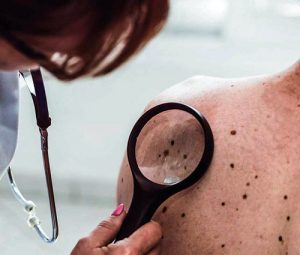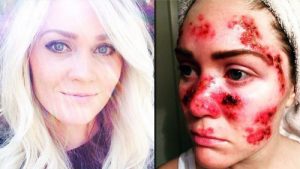
Sunny days are back again! If you stay outside a lot you might notice the appearance of some spots on your face or moles on your body so be careful! They might be more than just a simple reaction to the sun, and may lead to skin cancer.
Skin cancer is the most common form of cancer. It refers to a DNA mutation that begins in your skin when it is exposed to the sun. A tumor develops due to an uncontrolled cell division which leads to cells piling up on top of each other. It may start on any part of your skin and in some cases it spreads to nearby tissues and organs if the disease remains undetected.

What are the main types of skin cancer?
Keratinocyte cancer develops in skin cells called keratinocytes. It has two main subtypes, basal cell carcinoma (BCC) and squamous cell carcinoma (SCC).
Basal cell carcinoma (BCC)
BCC is the most common type of skin cancer and it usually develops on areas often exposed to the sun like the neck, back, face, scalp, hands and arms.
Squamous cell carcinoma (SCC)
SCC most commonly appears on areas of the body that are frequently exposed to the sun like BCC, and it may also develop in places that don’t get a lot of sun exposure. For example, it can develop on the genitals, inside the mouth, and on the lip.
Melanoma
Melanoma is the most serious type of skin cancer. It develops in the same skin cells that create moles (the skin melanocyte cells that generate the skin’s brown pigment.)
It can look like a harmless mole when it first develops and that’s why it’s very dangerous.
Fewer people develop melanoma than BCC or SCC however, it is responsible for the majority of deaths from skin cancer.
Actinic keratosis (AK)
AK is a less common type of skin cancer which is considered a pre-cancer.
Most people associate skin cancer with big, red bumps or brown spots. AK, on the other hand, presents as rough, dry, scaly patches that develop on skin that’s had frequent exposure to sun or artificial UV light, like tanning beds.

What does skin cancer look like?
Check yourself in the mirror for any of these signs:
• scaliness
• bleeding or oozing from a skin spot
• a sore that doesn’t heal in a normal time frame
• spreading pigment
• a mole with irregular borders
• sudden tenderness, itchiness, or pain
• a noticeable, fast-growing spot

Are we all at risk?
The older you get, the higher your chance for developing skin cancer. But melanoma is also one of the most frequently occurring cancers in young adults, especially women. That’s why the number one priority for all ages is protection from the sun’s UV rays, and from sunburn.
If you get severely sunburnt as a child, you are at an increased risk of getting skin cancer by 80%.
Now ladies pay extra attention: Tanning beds have been classified as “carcinogenic to humans” by the World Health Organization.
If you use tanning beds before the age of 40, you increase your risk of getting skin cancer by 69%.
You should pay extra attention if you have a family history of skin cancer, if you have an autoimmune disease, and furthermore if you smoke. These can all be warning signs to regularly check your skin for any visible signs like: moles, freckles or irregular growths.
Any change on your skin could be a potential cancer and you must have it checked by your doctor.

How to prevent it?
We know you will not stop going in the sun, especially when you live in a Mediterranean country. However, no matter where you are or how the weather is, there are some tips to protect yourself from the sun:
• Avoid the sun at its peak. Keep out of the sun when the UVA and UVB rays are strongest between 10AM and 4PM. If you have to be outside, try to stay in the shade.
• Sunscreen ON. No matter the time of day, apply and reapply sunscreen to all exposed areas of skin. Use a sunscreen with a sun protection factor (SPF) of at least 30. Also, your skin needs time to absorb the sunscreen, so you better apply it at least 30 minutes before you head out the door.
• Hats ON. Sunscreen on your scalp, face, and neck is more likely to wear off if you’re sweating so please wear a hat. Wide-brimmed hats are preferable, but a baseball cap is fine if you apply extra sunscreen to your ears and neck. Take care of the kids!
• Don’t forget your lips and your eyes. These extra sensitive areas need extra sun protection from UVA and UVB light. Make sure to apply sunblock to your lips and to wear sunglasses.
• No-No to UV lights. Tanning beds are linked to skin cancer so avoid using these artificial UV light sources.

What are some treatment options?
The good news is that if the skin cancer hasn’t spread, then your treatment will be very successful and you will totally recover from it. Now where you should be careful is in a successful early diagnosis, and that’s why you will have to trust a good doctor who will request a skin biopsy and reach a quick treatment decision.
Once you agree on the best solution, some treatment options will include: surgery, chemotherapy, radiation therapy, immunotherapy and photodynamic therapy.
Kindly refer to Dr. Costi for any questions or concerns, and remember what our favorite dermatologist always says: Always always always always wear sunscreen!